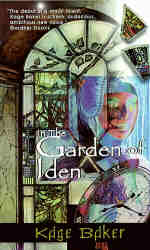In the Garden of Iden
Book written by Kage Baker
Great artists fall into two categories. Some generate fireworks because they seem to innovate out of nothing. Often, they appear to have few precursors. In some ways, their greatest work appears to bear hints of a different brain at work, to be kind. I’m thinking of Vincent Van Gogh, James Joyce, William Blake, and their ilk.
Then, there are those who synthesize their antecedents so magnificently that their art stuns with its creativity. These artists often bring to their work knowledge gained from other fields. Here would fit Johannes Vermeer, Orson Welles, and like-minded geniuses. We feel we can connect the dots, as it were, that lead to their art.
All artists do some of both. No artist lives their entire life in a paper bag unaffected by the world around them, just as all art leaps from input to output with at least some small part in the middle that can only be labelled “magic happens.” The greatest fallacy, however, is that the latter category (synthesizers) had to work for it, while the former group (fireworks) just sat at the cafe sipping espresso and awaiting inspiration.

What does all this have to do with a science fiction author like Kage Baker?
I started writing at a young age. A few years later, I started noticing the man behind the curtain in the things that I was reading. How did they set the scene? Carry off dialog? Make me feel something? Not surprisingly, I also started comparing my abilities to those of other writers. That led to one of two conclusions: 1) That’s just something I can’t do (and maybe never), but that’s all right; or 2) I could do that (especially if I bothered, which I probably won’t). This had to evolve, if only because it gets exhausting. So, the next stage became: 1) I don’t need to read any more of this; 2) I am going to finish this because it is good; or 3) OMG- this writer is pointing the way.
Tying back to the fireworks and the synthesizers, it is really hard to get something out of the path followed by one of those fireworks artists. Their work might be inspirational, but the way that they got there is difficult to delineate, by definition.
Kage Baker started publishing the fantastic stories and novels in 1997 when she was 45. Her Company series combines science fiction elements like time travel, well-researched history, and political thriller driven plots. Add to that incredible craft and talent.
I read Black Projects, White Knights first because it was huddled in the science fiction ghetto on the new book shelf at the library. Instantly hooked, I felt energized because someone new had emerged who wrote brilliantly with feeling. You just knew that the research had been heavy, but it also never felt like a lecture. The tone never condescended. It was like reading Bradbury or Sheckley or Kornbluth for the first time.
Naomi Novik and Jo Walton and Charles Stross, among others, have come along since- all of them pointing the way. I don;t know if it’s true or not, but I like to think Baker brought that new burst of inspiration.
What’s it all about?
You’ve Got to Check This Out is a blog series about music, words, and all sorts of artistic matters. It started with an explanation. 115 more to go.
New additions to You’ve Got to Check This Out release regularly. Also, free humor, short works, and poetry post irregularly. Receive notifications on Facebook by friending or following Craig.
Images may be subject to copyright.